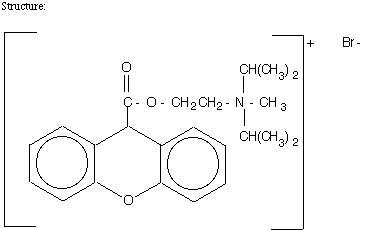
Descriptions of NTP Study Types

Descriptions of NTP Study Types
Home » Testing Information » Descriptions of NTP Study Types » Reproductive » Abstracts » Abstract for Repro Tox: Propantheline Bromide

Propantheline bromide (PB), used as an ulcer medication in humans, was tested for its effects on reproduction and fertility in CD-1 mice using the RACB protocol. Data on food and water consumption, body weights, and clinical signs during a two week dose-range-finding study (Task 1) were used to set exposure concentrations for the Task 2 continuous cohabitation study at 0.0, 0.05, 0.16, and 0.5% in feed. Based on mean body weight and average feed consumption data, the estimated daily doses were 71, 235, and 760 mg/kg body weight.
In the F0 animals, there were no deaths during Task 2. Body weight gain for the top dose males was reduced by a factor of 4, compared to controls. There was a statistically significant, but small (6%) reduction in the number of litters/pair at the top dose. The only other changes in reproductive indices for the F0 pairs occurred at the high dose level, and were a reduction in the mean weight of F1 pups adjusted for litter size at the top dose, by 4%, and an increase in the length of time to deliver each litter. This delay was greatest for the first three litters, while the difference was less for the last 2 litters.
These modest reproductive effects (6% decrease in litters/pair, and 4% decrease in adjusted live pup weight) were considered too small to be detectable in the single litter generated by the Task 3 crossover, so Task 3 was not conducted.
There were no adverse effects of PB consumption on the growth or viability of the F1 offspring in the last litter that was reared for second generation testing. After weaning the F2 mice, the F1 mice from control, middle and high dose groups were killed and necropsied. There were no weight changes or gross lesions noted in females, while male body weights were reduced by 11% at the top dose. There were no changes in sperm indices or in estrous cycle parameters.
Only mice from the control and high dose groups were kept and treated with PB from weaning to the mating trial at pnd 74 ± 10. Compared to controls, the high dose PB mice had similar-sized litters, with the same proportion of live pups, and same sex ratio, but the adjusted live pup weight was reduced by 11%.
After the delivery and evaluation of the F2 litters and estrous cycle data collection, the F1 adults were killed and necropsied. There was an 8% reduction in female body weight, and no change in organ weights. For males, body weight was reduced by 10%, and prostate weight was reduced by 25%. Epididymal sperm density was reduced at the high dose by 15%, while estrous cycle length and characteristics were unchanged.
Thus, propantheline bromide caused detectable but small reductions
in litter number, in both generations reduced adjusted pup weight,
and reduced F1 prostate weight and sperm count. These effects
were seen concomitant with male body weight changes but no other
significant non-reproductive toxicities.
Report Date: September 1985
Web page last updated on September 13, 2007
The National Institute of Environmental Health Sciences is one of the National Institutes of Health within the U.S. Department of Health and Human Services. The National Toxicology Program is headquartered on the NIEHS campus in Research Triangle Park, NC.